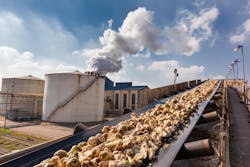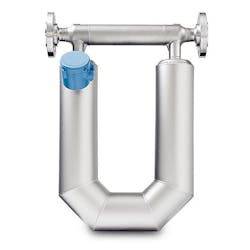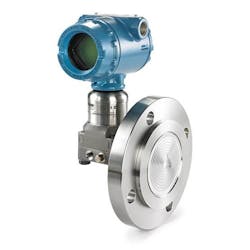The next big thing in sugar beet processing: Automation
By Tom Belling and Joshua Friesz, Emerson Automation Solutions
Larger-scale production of sugar from beets began back in Napoleonic France. Though we already knew how to extract sugar from beets, we can thank Napoleon for spurring the growth of this new industry. He needed an alternative source of sugar due to the British blockades of sugarcane during the war. With this demand for something sweet, a new process was born. However, sugar’s journey from lumpy root to tasty crystals is surprisingly complex. From washing the beets to crystallization, this multi-stage operation used to be extremely labor-intensive and potentially hazardous. Today, advanced technology makes this process safer and more efficient than ever before.
Processing the sugar beet: From whole root to packaged perfection
Sugar beets are hardier than sugarcane and can grow in colder climates and less nutrient-rich soil. Planted in spring and harvested in the early fall, sugar beet processing season kicks into high gear in September and usually lasts until the following April. These campaigns produce 20-30% of the world’s sugar. Byproducts from this production, molasses and beet pulp, are typically used for animal feed. Stones separated from beets during the washing stage are also repurposed into gravel for roads.
Once the beets are harvested and brought to the factory, the meticulous work of transforming these bulbous vegetables into sugary syrup and, ultimately, refined sugar begins. Each beet weighs around two pounds, about 18% of which is sucrose. To distill out the sucrose, the beets must be washed, broken down, and diffused into sugar water. From there, the liquid is sent through a purification process to remove impurities from the raw sugar juice. This product is sent through multiple filters and into evaporators, which creates a thick syrup ready for crystallization. A four-phase crystallization system heats the syrup (called thick juice) to evaporate the water, then seed crystals are introduced which causes the formation of sugar crystals.
Various measuring technologies, including flow, pressure, temperature, level, and analytical, enable manufacturers to optimize the steps of this sophisticated process. Precise measurements are necessary to prevent excess waste, maintain product integrity, and keep personnel safe. Advances in digitalization mean manufacturers are equipped with groundbreaking data intelligence to make better decisions, maximizing output and minimizing waste. Remote, wireless tools are used to save time and reduce risk.
The break down
The first steps of breaking down the beets involve considerable amounts of water — transporting the beets into the factory, washing them, and steeping them in an extraction tower. Water is utilized to move the beets from the entry flume into the washer and eventually through the slicer. Magnetic and Coriolis flow meters supply data on wastewater outlets, tracking water consumption, showing impurities and monitoring how much solid waste is going into their wastewater holding ponds. Understanding water usage helps with sustainability efforts, but it also assists with meeting wastewater disposal regulations.
Non-contacting radar and vibrating fork level detectors deliver accurate, remote measurements of water levels during transportation and in holding tanks to maintain adequate levels and avoid the dangers of manual measurements from above tanks or the flume.
After the beets are sliced into French fry-like strips called cossettes, they move onto the extraction tower. There, they diffuse in hot, temperature-controlled water, to extract the pulp's sucrose. Much like steeping tea, the hot water draws out the sucrose as the cossettes churn upwards from the bottom of the tower. Then, the solid waste is removed from the top of the diffusion tower to be dried and made into pellets.
Pressure and temperature transmitter technologies provide valuable information during diffusion, helping to control and enhance this process. Remote displays facilitate ease of access for technicians, eliminating the need for manual inspections at the tower. Transmitters with advanced diagnostic capabilities can also detect and diagnose problems during diffusion before they impact production. Differential pressure flow transmitters monitor airflow for blockages that would increase the risk of a fire in the driers during pulp processing.
Purification and evaporation
The raw juice exits the tower and moves onto the purification step. Calcium hydroxide (known as “lime milk”) is created in a nearby lime kiln to mix with the solution in several stages. Along with carbon dioxide, this mixture goes through a multiphase filtration process to absorb and remove impurities. From there, the liquid is pumped through several evaporators, reducing it to a thick syrup (usually called thick juice). A Brix measurement, which quantifies the amount of dissolved sugar in an aqueous solution, is taken before and after these stages to ensure product quality.
Automation technology is critical during purification. Flow meters are used to track the mass and density of the mixture as lime milk is added. The nature of the mixture means there is a risk of coating buildup on the flow meters, which can negatively affect these measurements' accuracy. However, innovative Coriolis flow meters with no moving parts and cutting-edge diagnostic software significantly mitigates this risk. Alerts let technicians know if issues arise before coating can throw off the data. These meters also take Brix measurement data all throughout this process, verifying that it doesn’t drop too low.
To maximize the amount of impurities removed from the mixture, pH levels must be monitored closely. Specialized equipment like sterilizable pH sensors verify pH levels as carbon dioxide is added, allowing the lime milk time to bond with impurities. Differential pressure flow transmitters are used to track the effectiveness of the purification filters as impurities are collected.
Maintaining proper level and temperature control is vital during the evaporation phase. Here, electronic remote sensor systems and temperature transmitters increase the reliability of these systems. The ability to connect remotely to all of this equipment gives technicians a window into their entire process from anywhere, so they always know exactly what is happening at any given moment and can make adjustments as necessary.
Crystallization
The final leg of this sweet journey is converting that viscous syrup into actual sugar crystals. Temperature controlled vacuum pans continue concentrating the sugar with hot water until it becomes supersaturated. Then, lab-grown seed crystals are added to the solution to stimulate sugar crystal growth. Continuous Brix measurements are taken so technicians know when to add the seed crystals. A centrifuge will then separate the crystals from the remaining syrup. This syrup goes on to storage in tanks to be used eventually as molasses. The sugar crystals are separated by grade, then dried, cooled, and packaged or stored in giant sugar silos.
Typically, crystallization is done in batches, but a few sugar beet processing plants have upgraded to equipment that enables continuous crystallization. Flow metering technology is essential here, especially in a continuous process that requires a high level of control. To accurately measure and control yield, flow meters are used on both the inputs and outputs to the vacuum pans. Data from these flow meters gives operators the necessary insight into the process to calculate the correct timing and quantities of inputs into the system. Pioneering technology has enhanced transmitters with historian data capabilities, magnifying the visibility we have into these processes.
Again, temperature analysis and calculating Brix come into play as well. Not only is temperature monitoring necessary during crystallization, but also as the crystals are sent through the dryers and coolers to become the sugar we know and love. Annubar flow meters keep track of airflow through ducts to ensure proper drying. RTD temperature sensors and temperature transmitters make sure the conveyor belts' conditions don't become dangerously high.
The future of sugar beet processing
Digitization is the new frontier for food and beverage processing plants. Depending on a plant’s needs, specific processes and current equipment, these modern technologies can take automation to a level previously unseen. Coriolis flow meters, magnetic flow meters, non-contacting radar measurement and various remote sensors and transmitters like those used in modernized sugar beet processing plants not only improve safety and reliability but also vastly improve overall outcomes. With the right technologies, the opportunity for optimizing production has never been greater.
Joshua Friesz is a global product manager for Emerson’s Automation Solutions business in Shakopee, Minnesota. He currently works with Rosemoun branded products and is focused on finding solutions for customers in the food and beverage or life science industries. Friesz joined Emerson in 2012 and holds a BSEE from North Dakota State University.
Tom Belling is a business development manager at Emerson, focused on the food and beverage industry. He has more than 20 years of experience with Coriolis flow and density measurements in the food and beverage industry segments of dairy, alcohol, beverage, grains and sugars. Tom holds a bachelor’s degree in business administration from Cardinal Stritch University.
About the Author
Joshua Friesz
Global product manager for Emerson’s Automation Solutions
Joshua Friesz is a global product manager for Emerson’s Automation Solutions business in Shakopee, Minnesota. He currently works with Rosemoun branded products and is focused on finding solutions for customers in the food and beverage or life science industries. Friesz joined Emerson in 2012 and holds a BSEE from North Dakota State University.


